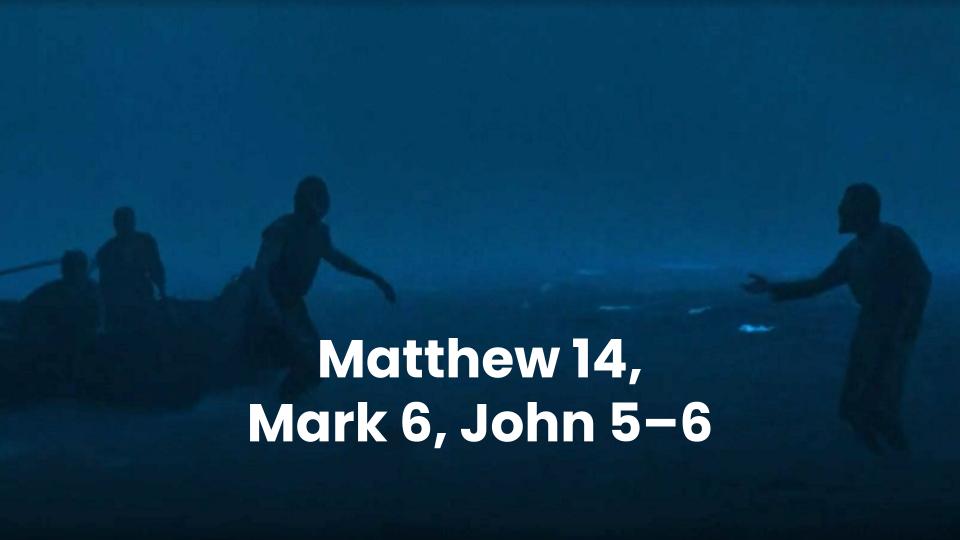Here are some ideas for learning and teaching a few of the great principles in Matthew 14, Mark 6, John 5–6. And while you’re here, I recommend you check out my free online course, “Seeking Jesus.”
Short Clips from The Chosen
These are three of the all-time best clips from “The Chosen.” Use them this week! See this page for tips on teaching with “The Chosen.”
Matthew 14:14-21, Jesus Feeds the 5,000
Matthew 14:22-32, Jesus and Peter Walk on Water
John 5:1-13, Jesus Heals at the Pool of Bethesda
Short Clips from Seeking Jesus
I’ve pulled out short clips from the “Seeking Jesus Course” connected to this week’s readings that you could use as a morning devotional or spiritual thought.
Jesus Feeds the Multitudes
The Fourth Watch
Stilling the Storms
Do You Want to Be Made Well?
Will You Go Away?
The Gospel of John Movie
The Gospel of John is a great movie about Jesus Christ. You can learn more about it on this page; here are the video links to John chapter 5 and chapter 6 as portrayed in this movie. See the teaching idea below as well.
Follow me on Instagram or sign up here for more Come Follow Me insights.
Ideas for Teaching Matthew 14, Mark 6, John 5–6
***You’re A Hollywood Critic***
Invite a student to read John 5:36-47. Before the student starts to read, ask everyone else to imagine how they would depict this scene if they were creating a film version of it.
After the reading, watch this short video clip (less than 2 minutes) of a film depiction of this scene. Before watching, let students know that while the film uses a different Bible translation, it is word-for-word John 5:36-47. After watching the video clip, ask students for their reaction—what did they like? What did they not like? How might they have filmed it differently?
Some people don’t like Christ’s tone of voice in this video. Remember—this is just a movie, we don’t know how this happened. At the same time, how does one say, “I know you, that ye have not the love of God in you” nicely? (See John 5:42).
Again, the point isn’t that the video is accurate, but it can help us to think about different ways in which scene might have taken place and help it come alive.
***Avoiding Prooftexting***
Prooftexting is when you take a verse out of context and make it say something that the original author didn’t intend. John 5:39 is a verse that is often prooftexted and studying and teaching it this week gives us an opportunity to help students understand what Christ is really saying.
In John 5:39, Jesus says, “Search the scriptures; for in them ye think ye have eternal life: and they are they which testify of me” (John 5:39).
True or false: What Jesus is telling the people in this verse is that you should search the Scriptures.
This is actually false. Although we tend to focus on is the phrase “search the scriptures,” we miss what comes next: “in them you think you have eternal life.”
In the KJV, “Search the scriptures” sounds like a command, but it’s not that way in the Greek. Let’s look at a couple of different Bible translations of John 5:39-40 that could help clarify what Jesus is saying:
“You search the scriptures because you think that in them you have eternal life, and it is they that testify on my behalf. Yet you refuse to come to me to have life” (New Revised Standard Version).
“You search the Scriptures because you think they give you eternal life. But the Scriptures point to me!” (New Living Translation).
In context Jesus is talking to a group of people who are rejecting Him, but they frequently search the scriptures. What he’s saying is, “You’re missing the mark. You’re so focused on the scriptures, that you can’t see that they are testifying of me.”
Just to clarify, is it good to search the scriptures? Absolutely. That’s just not what Jesus is teaching in this specific passage. What he is saying is that the scriptures point to Jesus Christ. That’s why we study them.
Nephi taught this same principle when he wrote, “We labor diligently to write, to persuade our children, and also our brethren, to believe in Christ…And we talk of Christ, we rejoice in Christ, we preach of Christ, we prophesy of Christ, and we write according to our prophecies, that our children may know to what source they may look for a remission of their sins” (2 Nephi 25:23, 26).
Helping students better understand John 5:39-40 can encourage them to study the scriptures not as a checklist item, but as a way to focus on and draw closer to Christ.
***Will You Go Away?***
Ask students to share what they feel are some of the “hard sayings” in the church today. Depending on the ages of those you’re teaching, responses might include certain gospel teachings or standards, issues in church history, etc. Explain that in John 6, Jesus taught some “hard sayings.” Invite students to read John 6:60-61, 66-69 and have students look for some principles regarding how we can stay strong when things get hard.
Something I would want to communicate to students is the idea that when the hard saying came, there were two responses. Some of the disciples left and others stayed. What helped people stay? It was their firm testimony of Jesus Christ.
When the hard times and the hard sayings come, we have a choice. We can say “This is a hard saying who can hear it?” quit, and use it as an excuse to walk no more with Jesus. Or I could say, “I don’t really fully understand such and such an issue, but I believe and am sure that Jesus Christ is the son of God. So I am staying on his team.”
***Get Out of the Boat***
Tell students about the scariest moment of your life. Let 1-2 students share their scariest moment with the class. Turn to Matthew 14:22-33 and read about one of Peter’s most terrifying moments. Ask students to share lessons they see in Peter’s story that they could apply in their own lives when they feel scared.
For teachers: in this 2011 talk to Seminary and Institute teachers, Elder David A. Bednar applies the story of getting out of the boat to teachers. The whole address is awesome, for the sections of the talk that address “getting out of the boat” watch 4:13-6:26 and 22:05-28:26.
***
I hope these resources are helpful to you in your learning and teaching this week!
Do you want more learning and teaching tips for Come Follow Me? Follow me on Instagram or sign up here for emails with insights on Come Follow Me.






